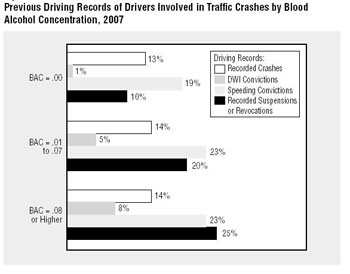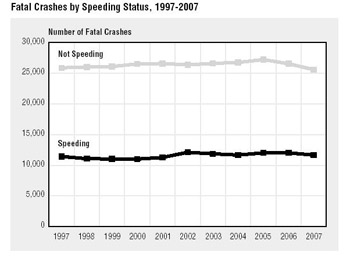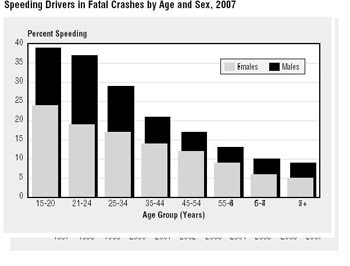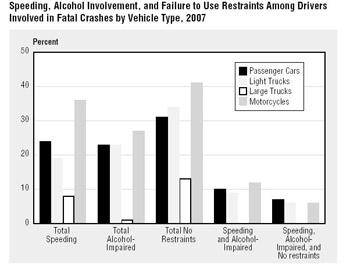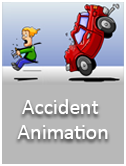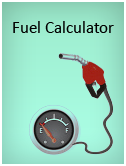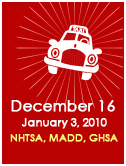Alcohol Impaired Driving Fatalities
Alcohol
In 2007, there were 12,998 alcohol-impaired-driving fatalities. This is a decrease of 4 percent compared to 2006 (13,491 fatalities), and it represents an average of one alcohol-related fatality every 40 minutes. The 12,998 alcohol-impaired-driving fatalities in 2007 (32% of total traffic fatalities for the year) represent a 2-percent increase from the 12,757 alcohol impaired- driving fatalities reported in 1997 (30% of the total)
Over 1.46 million drivers were arrested in 2006 for driving under the influence of alcohol or narcotics. This is an arrest rate of 1 for every 139 licensed drivers in the United States. In fatal crashes in 2007, 27 percent of motorcycle riders had BAC levels of .08 g/dL or higher, as compared with 23 percent for drivers of light trucks, 23 percent for passenger car drivers, and 1 percent for drivers of large trucks. In fatal crashes in 2007, the highest percentages of drivers with BAC levels of .08 g/dL or higher were recorded for drivers 21 to 24 years old (35%), followed by ages 25 to 34 (29%) and 35 to 44 (25%).
Speeding
NHTSA considers a crash to be speeding-related if the driver was charged with a speeding-related offense or if an officer indicated that racing, driving too fast for conditions, or exceeding the posted speed limit was a contributing factor in the crash.
Speeding is one of the most prevalent factors contributing to traffic crashes. The economic cost to society of speeding-related crashes is estimated by NHTSA to be $40.4 billion per year. In 2007, speeding was a contributing factor in 31 percent of all fatal crashes, and 13,040 lives were lost in speeding-related crashes.
For drivers involved in fatal crashes, young males are the most likely to be speeding. With the increase in driver age, the proportions of all crashes that are speeding-related have decreased. In 2007, 39 percent of the 15- to 20-year-old male drivers who were involved in fatal crashes were speeding at the time of the crash.
In 2007, 88 percent of speeding-related fatalities occurred on roads that were not Interstate highways. Alcohol and speeding are clearly a deadly combination. Speeding involvement is prevalent for drivers involved in alcohol-related crashes. In 2007, 40 percent of the drivers with BAC levels of .08 g/dL or higher who were involved in fatal crashes were speeding, compared with only 15 percent of the drivers with BAC levels of .00 (i.e., no alcohol) involved in fatal crashes.
Motorcycles
The 5,154 motorcyclist fatalities in 2007 accounted for 13 percent of all traffic fatalities for the year. An additional 103,000 motorcyclist were injured. Per vehicle mile traveled in 2006, motorcyclists were 35 times more likely than passenger car occupants to die in a motor vehicle traffic crash and 8 times more likely to be injured (motorcycle VMT data is not available for 2007).
In 2007, 36 percent of all motorcycle riders involved in fatal crashes were speeding, as compared to 24 percent for passenger car drivers, 19 percent for light-truck drivers, and 8 percent for large-truck drivers.
In 2007, 41 percent of fatally injured motorcycle riders and 53 percent of fatally injured passengers were not wearing helmets at the time of the crash.Over one-fourth of motorcycle riders (26%) involved in fatal crashes in 2007 were driving the vehicles with invalid licenses at the time of the collision.The percentage of motorcycle riders involved in fatal crashes in 2007 who had BAC levels of .08 g/dL or higher 27 percent was higher than for any other type of motor vehicle driver.NHTSA estimates that helmets saved the lives of 1,784 motorcyclists in 2007.If all motorcyclists had worn helmets, an additional 800 lives could have been saved.
A modish motorcycle fairing for excellent sale, so kindly visit Customcyclepros



